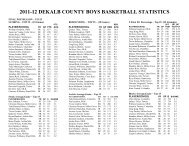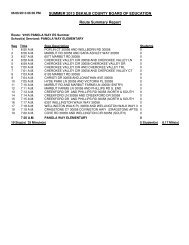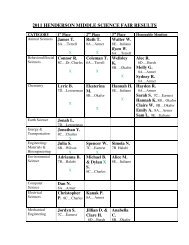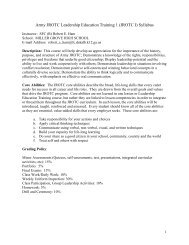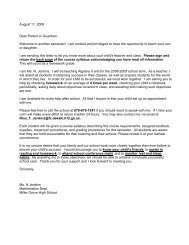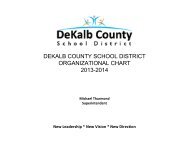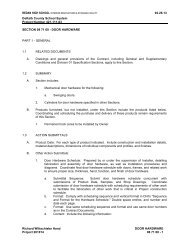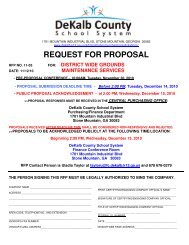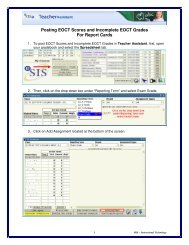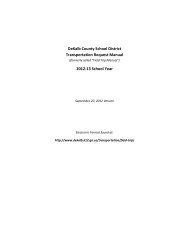Comparison of QCC & GPS Course Content - DeKalb County Schools
Comparison of QCC & GPS Course Content - DeKalb County Schools
Comparison of QCC & GPS Course Content - DeKalb County Schools
You also want an ePaper? Increase the reach of your titles
YUMPU automatically turns print PDFs into web optimized ePapers that Google loves.
GaDOE Mathematics Curriculum<strong>Comparison</strong> <strong>of</strong> <strong>QCC</strong> & <strong>GPS</strong> <strong>Course</strong> <strong>Content</strong>Revised 11-29-07<strong>QCC</strong><strong>Course</strong>s6 thGrade<strong>GPS</strong>Mathematics7 thGrade<strong>GPS</strong>Mathematics8 thGrade<strong>GPS</strong>MathematicsAlgebra IVariables,algebraicexpressions, linearequations andinequalities,radical andrationalexpressions,polynomials, linearand quadraticfunctions, systems<strong>of</strong> equations andinequalities,calculators andcomputersGeometryInformal and formal logicalreasoning processesincluding deductive andinductive reasoning;synthetic, coordinate, andtransformationalapproaches to congruence;similarity, parallelism,symmetry, andperpendicularity; perimeterand area <strong>of</strong> 2-dimensionalfigures; surface area andvolume <strong>of</strong> 3-dimensionalfigures; integration <strong>of</strong>algebraic skills and conceptsto solve geometric problemsAlgebra IIUse <strong>of</strong> calculatorsand computers toassist problemsolving; polynomial,exponential, andlogarithmicfunctions; irrationaland complexnumbers; graphing;systems <strong>of</strong> linearequations andinequalities;quadratics;probability;statistics; sequencesand seriesAdvanced Algebra and TrigonometryEnhancement <strong>of</strong> algebraic skills andintroduction <strong>of</strong> trigonometrythrough calculators and computers;real and complex numbers; vectors;matrices; sequences; series;probability; statistics; conicsections; functions; and problemsolvingAnalysisAll topics included in AdvancedAlgebra and Trigonometry, furtherstudy <strong>of</strong> relations and functions,trigonometry, analytical geometry,complex numbers, set theory andlogicStatisticsApplications <strong>of</strong> statisticalmethods in problem solvingusing data collected throughexperimentation, computersimulations, and varioussources; opportunities tomodel statistical methods,derive probabilities, andmake inferences;applications <strong>of</strong> statistics inreal-life situations; examples<strong>of</strong> how misleading statisticscould be better presentedFactors and multiples; Fundamental Theorem <strong>of</strong> Arithmetic; GCF & LCM; compute with fractions and mixed numbers (unlike denominators);equivalent fractions, decimals, and percents; convert units using proportionsRelationships between varying quantities; write & solve proportions; write & solve simple one-step equations; evaluate algebraic expressionsVolume <strong>of</strong> rectangular prisms, cylinders, pyramids and cones; surface area <strong>of</strong> rectangular prisms and cylinders; line &rotational symmetry; ratio, proportion, and scale factor with similar plane figures; scale drawings; compare and contrastprisms, pyramids cylinders and cones; nets <strong>of</strong> prisms, cylinders, pyramids, and cones; 2-dimensional perspectives <strong>of</strong> 3 -dimensional objectsPose questions, collect data, and represent datausing appropriate graphs; experimental andtheoretical probability; make predictions frominvestigationsAbsolute Value; compare & order rational numbers; compute & solve problems with positive and negative numbers; simplify and operate withalgebraic expressions; understand and apply linear equations in one-variable; analyze relationships between two variables using tables, graphs,and formulas; direct and inverse proportionsBasic constructions; transformations; properties <strong>of</strong> similarity; 3-D figures formed by translations and rotations in space;cross sections <strong>of</strong> cones, cylinders, pyramids, and prismsPose questions, collect data, represent and analyzedata; interpret resultsSquare roots <strong>of</strong> perfect squares; rational vs. irrational numbers; simplify expressions with integer exponents; scientific notation; represent,analyze, and solve problems; inequalities in one variable; relations and linear functionsProperties <strong>of</strong> parallel and perpendicular lines; meaning <strong>of</strong> congruence; Pythagorean TheoremSet theory; tree diagrams, counting principles; basiclaws <strong>of</strong> probability; organize, interpret, and makeinferences from dataThe standards for middle school mathematics courses may be compacted to allow entry into high school level courses.CRCTs must be taken at the appropriate grades levels as required.Algebra I Geometry Algebra II Advanced Algebra and Trigonometry and Analysis Statistics CalculusGeorgia Department <strong>of</strong> EducationKathy Cox, State Superintendent <strong>of</strong> <strong>Schools</strong>December 3, 2007 • Page 1 <strong>of</strong> 4All Rights Reserved
GaDOE Mathematics Curriculum<strong>Comparison</strong> <strong>of</strong> <strong>QCC</strong> & <strong>GPS</strong> <strong>Course</strong> <strong>Content</strong>Revised 11-29-07<strong>QCC</strong><strong>Course</strong>sMathematics I:Algebra/Geometry/StatisticsAcceleratedMathematics I:Geometry/Algebra II/StatisticsAlgebra IVariables,algebraicexpressions, linearequations andinequalities,radical andrationalexpressions,polynomials,linear andquadraticfunctions, systems<strong>of</strong> equations andinequalities,calculators andcomputersGeometryInformal and formal logicalreasoning processesincluding deductive andinductive reasoning;synthetic, coordinate, andtransformationalapproaches to congruence;similarity, parallelism,symmetry, andperpendicularity;perimeter and area <strong>of</strong> 2-dimensional figures;surface area and volume <strong>of</strong>3-dimensional figures;integration <strong>of</strong> algebraicskills and concepts to solvegeometric problemsAlgebra IIUse <strong>of</strong> calculatorsand computers toassist problemsolving; polynomial,exponential, andlogarithmicfunctions; irrationaland complexnumbers; graphing;systems <strong>of</strong> linearequations andinequalities;quadratics;probability;statistics; sequencesand seriesAdvanced Algebra andTrigonometryEnhancement <strong>of</strong> algebraic skillsand introduction <strong>of</strong> trigonometrythrough calculators andcomputers; real and complexnumbers; vectors; matrices;sequences; series; probability;statistics; conic sections;functions; and problem solvingAnalysisAll topics included in AdvancedAlgebra and Trigonometry, furtherstudy <strong>of</strong> relations and functions,trigonometry, analytical geometry,complex numbers, set theory andlogicStatisticsApplications <strong>of</strong> statisticalmethods in problem solvingusing data collected throughexperimentation, computersimulations, and varioussources; opportunities tomodel statistical methods,derive probabilities, andmake inferences;applications <strong>of</strong> statistics inreal-life situations;examples <strong>of</strong> how misleadingstatistics could be betterpresentedRadical, polynomial, and rational expressions; quadratic, rational, and radical equationsArgument and justification, including inductive and deductive reasoning; pro<strong>of</strong>; discovery, pro<strong>of</strong> and application <strong>of</strong>properties <strong>of</strong> polygons; use <strong>of</strong> the coordinate plane to investigate and verify properties <strong>of</strong> geometric figuresCharacteristics and transformations <strong>of</strong> functions and their graphs; sequences as functionsPermutations and combinations; laws <strong>of</strong>probability; comparison <strong>of</strong> samples andpopulation using summary statistics; meanabsolute deviationRadical, polynomial, and rational expressions; quadratic, rational, and radical equationsArgument and justification, including inductive and deductive reasoning; pro<strong>of</strong>; discovery, pro<strong>of</strong>, and application <strong>of</strong>properties <strong>of</strong> polygons; use <strong>of</strong> the coordinate plane to investigate and verify properties <strong>of</strong> geometric figures; properties <strong>of</strong>circles; measures <strong>of</strong> spheresCharacteristics and transformations <strong>of</strong> functions and their graphs; sequences as functions;complex numbers; quadratic and piecewise functions; quadratic equations and inequalities,including equations with complex solutionsPermutations and combinations; laws <strong>of</strong>probability; comparison <strong>of</strong> samples andpopulation using summary statistics; meanabsolute deviation; curve fittingAlgebra I Geometry Algebra II Advanced Algebra and Trigonometry and Analysis Statistics CalculusGeorgia Department <strong>of</strong> EducationKathy Cox, State Superintendent <strong>of</strong> <strong>Schools</strong>December 3, 2007 • Page 2 <strong>of</strong> 4All Rights Reserved
GaDOE Mathematics Curriculum<strong>Comparison</strong> <strong>of</strong> <strong>QCC</strong> & <strong>GPS</strong> <strong>Course</strong> <strong>Content</strong>Revised 11-29-07<strong>QCC</strong> <strong>Course</strong>sMathematics II:Geometry/Algebra II/StatisticsAcceleratedMathematics II:AdvancedAlgebra/Geometry/StatisticsAlgebra IVariables,algebraicexpressions,linear equationsand inequalities,radical andrationalexpressions,polynomials,linear andquadraticfunctions,systems <strong>of</strong>equations andinequalities,calculators andcomputersGeometryInformal and formal logicalreasoning processesincluding deductive andinductive reasoning;synthetic, coordinate, andtransformationalapproaches to congruence;similarity, parallelism,symmetry, andperpendicularity;perimeter and area <strong>of</strong> 2-dimensional figures;surface area and volume <strong>of</strong>3-dimensional figures;integration <strong>of</strong> algebraicskills and concepts to solvegeometric problemsAlgebra IIUse <strong>of</strong> calculatorsand computers toassist problemsolving; polynomial,exponential, andlogarithmicfunctions; irrationaland complexnumbers; graphing;systems <strong>of</strong> linearequations andinequalities;quadratics;probability;statistics; sequencesand seriesAdvanced Algebra andTrigonometryEnhancement <strong>of</strong> algebraic skillsand introduction <strong>of</strong> trigonometrythrough calculators andcomputers; real and complexnumbers; vectors; matrices;sequences; series; probability;statistics; conic sections;functions; and problem solvingAnalysisAll topics included in AdvancedAlgebra and Trigonometry, furtherstudy <strong>of</strong> relations and functions,trigonometry, analytical geometry,complex numbers, set theory andlogicStatisticsApplications <strong>of</strong> statisticalmethods in problem solvingusing data collected throughexperimentation, computersimulations, and varioussources; opportunities tomodel statistical methods,derive probabilities, andmake inferences;applications <strong>of</strong> statistics inreal-life situations;examples <strong>of</strong> how misleadingstatistics could be betterpresentedRight triangle trigonometry, special right triangles, properties <strong>of</strong> circles, measures <strong>of</strong> spheresComplex numbers; quadratic equations and inequalities, including equations with complexsolutions; piecewise, exponential, and inverse functions; absolute valuePopulations means, standard deviations, andstatistical inferencesRight triangle trigonometry, special right triangles, relationships between lines and circlesExponential, logarithmic, and higher degree polynomial functions; inverses <strong>of</strong> functionsMatrices; vertex-edge graphs; conic sections; planes and spheresUse <strong>of</strong> sample data to make inferences aboutpopulations, comparison <strong>of</strong> data sets usingmeans and standard deviations; probabilityhistograms; experimental versusobservational studies; standard deviationsand normal distributionsAlgebra I Geometry Algebra II Advanced Algebra and Trigonometry and Analysis Statistics CalculusGeorgia Department <strong>of</strong> EducationKathy Cox, State Superintendent <strong>of</strong> <strong>Schools</strong>December 3, 2007 • Page 3 <strong>of</strong> 4All Rights Reserved
GaDOE Mathematics Curriculum<strong>Comparison</strong> <strong>of</strong> <strong>QCC</strong> & <strong>GPS</strong> <strong>Course</strong> <strong>Content</strong>Revised 11-29-07<strong>QCC</strong> <strong>Course</strong>sMathematics III:AdvancedAlgebra /StatisticsAcceleratedMathematics III:Pre-Calculus –Trigonometry/StatisticsMathematics IV:Pre-Calculus –Trigonometry/StatisticsAlgebra IVariables,algebraicexpressions,linear equationsand inequalities,radical andrationalexpressions,polynomials,linear andquadraticfunctions,systems <strong>of</strong>equations andinequalities,calculators andcomputersGeometryInformal and formal logicalreasoning processesincluding deductive andinductive reasoning;synthetic, coordinate, andtransformationalapproaches to congruence;similarity, parallelism,symmetry, andperpendicularity;perimeter and area <strong>of</strong> 2-dimensional figures;surface area and volume <strong>of</strong>3-dimensional figures;integration <strong>of</strong> algebraicskills and concepts to solvegeometric problemsAlgebra IIUse <strong>of</strong> calculatorsand computers toassist problemsolving; polynomial,exponential, andlogarithmicfunctions; irrationaland complexnumbers; graphing;systems <strong>of</strong> linearequations andinequalities;quadratics;probability;statistics; sequencesand seriesAdvanced Algebra andTrigonometryEnhancement <strong>of</strong> algebraic skillsand introduction <strong>of</strong> trigonometrythrough calculators andcomputers; real and complexnumbers; vectors; matrices;sequences; series; probability;statistics; conic sections;functions; and problem solvingAnalysisAll topics included in AdvancedAlgebra and Trigonometry, furtherstudy <strong>of</strong> relations and functions,trigonometry, analytical geometry,complex numbers, set theory andlogicStatisticsApplications <strong>of</strong> statisticalmethods in problem solvingusing data collected throughexperimentation, computersimulations, and varioussources; opportunities tomodel statistical methods,derive probabilities, andmake inferences;applications <strong>of</strong> statistics inreal-life situations;examples <strong>of</strong> how misleadingstatistics could be betterpresentedExponential, logarithmic, and higher degree polynomial functions; solving a variety <strong>of</strong>equations and inequalities by appropriate means; relationships between lines and circlesMatrices and vertex-edge graphs; conic sections, planes and spheresProbability histograms; experimental versusobservational studies; normal distributionsCircular trigonometry; trigonometric functions and their inverses;trigonometric identities and equations; rational functions;investigations <strong>of</strong> the properties <strong>of</strong> a variety <strong>of</strong> functions, sequencesand series; vectorsCentral limit theorem and confidenceintervalsPolar and parametric equationsCircular trigonometry; trigonometric functions and their inverses;trigonometric identities and equations; rational functions;investigations <strong>of</strong> the properties <strong>of</strong> a variety <strong>of</strong> functions, sequencesand series; vectorsCentral limit theorem and confidenceintervalsAlgebra I Geometry Algebra II Advanced Algebra and Trigonometry and Analysis Statistics CalculusGeorgia Department <strong>of</strong> EducationKathy Cox, State Superintendent <strong>of</strong> <strong>Schools</strong>December 3, 2007 • Page 4 <strong>of</strong> 4All Rights Reserved



